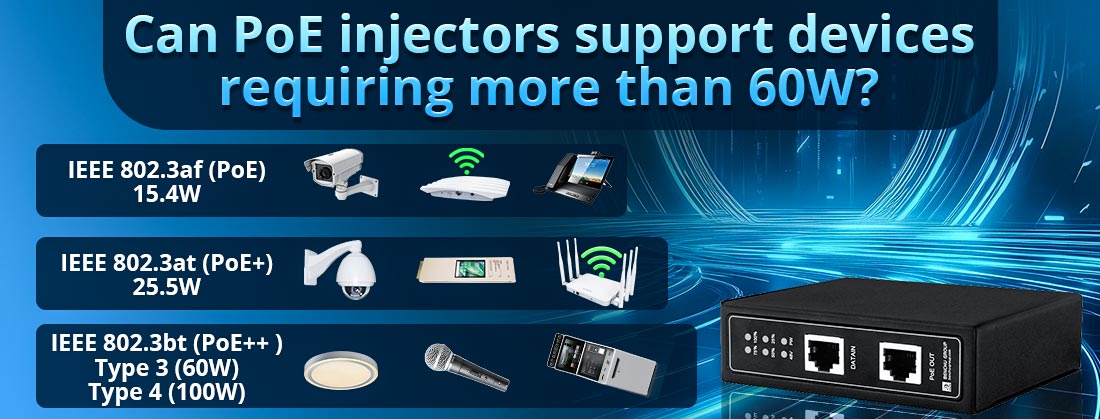
Oui, les injecteurs Power Over Ethernet (POE) peuvent prendre en charge les dispositifs nécessitant plus de 60 W, mais cela dépend du type de norme POE que l'injecteur prend en charge. Voici une ventilation:
1. IEEE 802.3af (POE) - 15.4W
Sortie de sortie: jusqu'à 15,4 W par port, adapté aux appareils comme les téléphones IP, les caméras et les petits points d'accès.
Pas suffisant pour les appareils nécessitant plus de 60 W.
2. IEEE 802.3at (Poe +) - 25,5W
Sortie de sortie: jusqu'à 25,5 W par port, conçu pour alimenter les appareils avec des besoins plus élevés, comme certains points d'accès et des caméras IP plus avancées.
Toujours pas assez pour les appareils dépassant 60W.
3. IEEE 802.3bt (Poe ++ ou 4ppoe)
Cette norme est disponible en deux classes de puissance:
--- Type 3 (60W): jusqu'à 60W par port. Cela peut prendre en charge les appareils comme certains points d'accès haute puissance, caméras PTZ ou périphériques réseau avancés.
--- Type 4 (100W): jusqu'à 100W par port. Ceci est conçu pour les appareils haute puissance, tels que les caméras PTZ plus grandes, les systèmes de vidéoconférence et les appareils qui ont besoin de plus d'énergie pour le fonctionnement.
4. Injecteurs Poe pour> 60W
Dispositifs supérieurs à 60W: pour prendre en charge les appareils qui ont besoin de plus de 60W, vous avez besoin d'un Injecteur Poe ++ qui prend en charge le type 4 (100W).
Exemples de dispositifs: points d'accès haute performance, appareils réseau et systèmes de surveillance vidéo avec des besoins plus élevés.
Considérations: assurez-vous que l'injecteur et l'appareil sont conformes à la norme 802.3bt Type 4. Le câble (Cat 5E ou plus) devrait également prendre en charge la livraison de puissance.
5. Solutions de puissance alternative:
Si l'injecteur ne peut pas fournir une puissance suffisante ou si vous travaillez avec un appareil non POE, vous devrez peut-être utiliser une alimentation séparée ou un séparateur POE actif qui peut fournir plus de puissance.
Résumé:
Pour prendre en charge les dispositifs nécessitant plus de 60W, vous avez besoin d'injecteurs PoE ++ conformes à l'IEEE 802.3bt Type 4 (100W). Il est essentiel de s'assurer que l'injecteur et le dispositif alimenté prennent en charge cette puissance plus élevée pour une fonctionnalité appropriée.